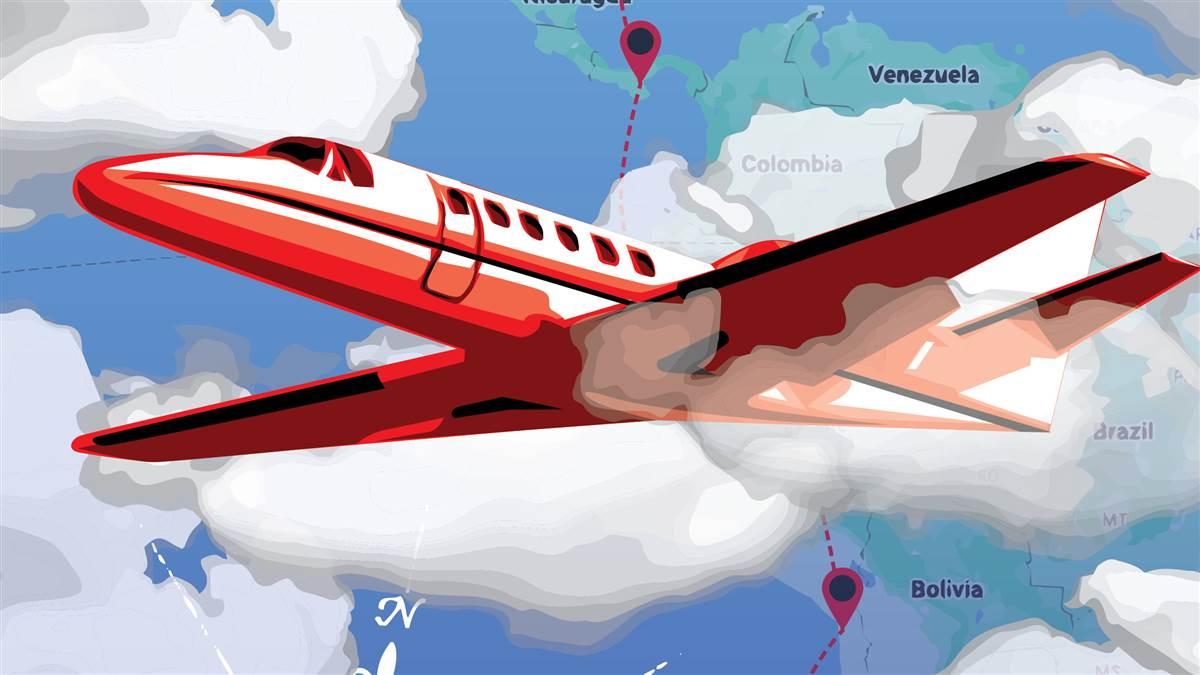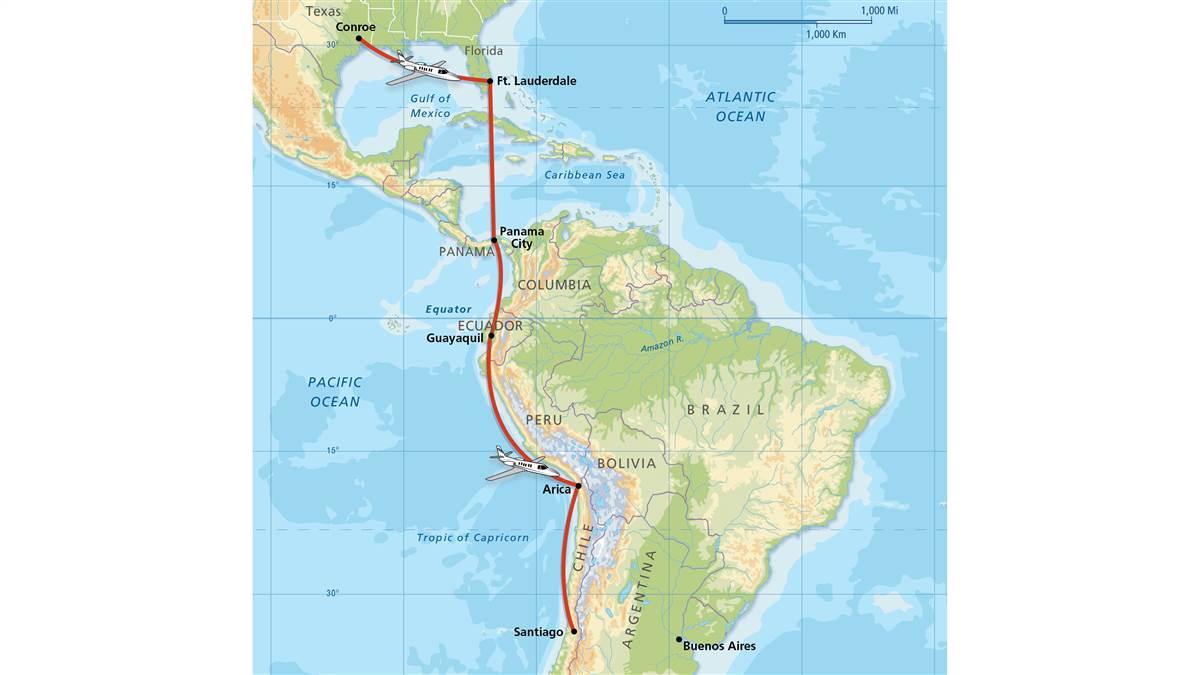Learning experience
Ferrying a Citation II on its last trip 4,500 miles south

The airplanes were part of an airworthy fleet that CBP was retiring. Sensitive equipment was removed, including more than 350 pounds of sensing gear on te and lots of screens and gauges from the cockpit.
Placing these aircraft back to work was a labor of love. First, we reviewed the online maintenance system and determined what mandatory inspections and airworthy directives were missing and hired a local shop at the Conroe-North Houston Regional Airport (CXO) to perform the work. Then came the avionics upgrade, including two Garmin 750s as specified in the supplemental type certificate of Jettech LLC in Denver, Colorado. From 2016 to 2020 we used three of the aircraft in mapping missions in the U.S. and Mexico, and in early 2021 decided to retire N26621, which had not flown in three years.
In a matter of days, we received a good offer from a buyer in Chile, and in a matter of weeks, the deal was done. The new owner hired me to arrange an international ferry permit with the FAA and gave me the responsibility of flying it. My certifications for the Citation II are limited to second in command, so I scrambled to secure a pilot while dealing with the paperwork for the ferry permit.
An international ferry permit issued by the FAA only authorizes flights in the national airspace system of the United States; it requires an authorization from each air navigation service provider from every country we were planning to fly over. This meant we had to obtain overflight permits from Cuba, Jamaica, Panama, Colombia, Ecuador, Peru, and Chile.
This was a bureaucratic nightmare, to put it mildly, since some of these countries only issue overflight permits with validities ranging from 24 hours to 72 hours, depending on the aircraft and route of flight.
Further complicating the logistics, the aircraft was plagued with small issues that needed to be resolved before taking off from Conroe, and the airplane did not meet ICAO requirements to fly in reduced vertical separation minimum airspace, so we had to prepare a flight plan that included many fueling stops in different countries in the middle of a pandemic.
We did not want to spend a night in any of these countries unless it was necessary, but the flight plan was giving us a flying time of 15 hours, which grossly exceeds a safe duty time.

The physical inspection by the FAA was scheduled for March 10, and I was running out of time to find a pilot, so I called the owner in Chile and shared my difficulties. His response was not to worry, he would send his chief pilot, Anibal, the next day, so we could make the flight together. He assured me that Anibal knew the route and had done this same flight dozens of times in different aircraft.
The FAA inspection went well, and on March 10 we received our ferry permit valid for 10 days. Now the race was on to finish fixing the mechanical issues and to fine-tune the route to make sure we could do the flight in the allotted time. International ferry permits issued by the FAA and originating, but not ending, in the United States have a few interesting details. One is that they authorize the crew of a non-airworthy aircraft to fly in the national airspace system using a predetermined route on specific dates and authorize a departure from a specified airport on an international flight plan. After that, it is up to the different air navigation service providers to keep track of the flight.
Anibal arrived in Conroe on March 11, and we had a meeting with the mechanics to determine the feasibility of taking off on March 12. They were having problems with pressurization but assured us the airplane would be ready on time.
Anibal and I reviewed the issue of duty time and decided to schedule a replacement crew to be ready at the Arica Airport to relieve us and do the last leg.
The next day, once all issues were resolved, we took off on our first leg from Conroe to Fort Lauderdale Executive (FXE), where we would do our customs and immigration for an international departure.
Unfortunately, as soon as we took off and changed our frequency to Houston Departure, the air traffic controller notified us that ATC was not receiving our Mode C transponder. We reset the breakers and checked every possible scenario, but eventually requested vectors for our return to Conroe.
Thankfully, the mechanics were monitoring the departure frequency and knew that we were coming back. As soon as we parked on the ramp they began troubleshooting, and late in the afternoon the issue was resolved. It was too late to start the three-hour leg to Fort Lauderdale, and we did not want to fly at night.
Fort Lauderdale – Panama City
On March 13 we took off early, and this time Mode C worked. As soon as we reached 18,000 feet there was a pressurization alarm, but we engaged the second air cycle machine, and the emergency was resolved. We landed in Fort Lauderdale at noon and asked the local FBO to look at the pressurization system.
Unfortunately, the mechanics at FXE determined that parts were needed, and the continuation of our flight was delayed until Thursday, March 18. During the off time in Fort Lauderdale, all international ferry permits expired and had to be renewed.
At 5:30 a.m. on March 18 we took off from FXE and arrived in Panama City 3.8 hours later. The refueling only took 45 minutes, and before noon we were in the air on our way to Guayaquil, Ecuador.
Panama City - Guayaquil
The leg from Panama City to Guayaquil was the shortest—2.3 hours—but was the one with potential instrument conditions on arrival. As forecast, we had low ceilings and steady precipitation with visibility less than 10 miles, so we executed the RNAV approach to Runway 3. Once again, the turnaround time was 45 minutes, and in the early hours of the afternoon we took for Arica (SCAR) in Chilean territory.
Guayaquil, Ecuador – Arica, Chile
As soon as we reached our cruise altitude of 28,000 feet, we had the second emergency of the week when the altitude indicator on the pilot side went crazy and began showing a steep climb, which the autopilot tried to counter by a strong push downward. Anibal promptly disconnected the autopilot and instructed me to recycle the breakers associated with the altitude and vertical speed indicators. For a few seconds while the system reset itself, we flew manually, hoping the gauge would return to normal, which it did in less than a minute.
This was the longest and most challenging leg of the trip. The distance and potential deviations presented a threat to our ability to reach Arica without an extra stop somewhere in Peru, so we flew using the best distance-to-fuel ratio and with the help of the Peruvian air traffic controllers. We landed in Arica, on the border with Peru, at 6 p.m. with 45 minutes of reserve. The shortcuts and lack of deviations allowed us to complete the flight in 3.6 hours.
That leg was the last for Anibal and I; the replacement crew took over after completing Chilean customs and immigration, plus a COVID-19 protocol for international crews.
Arica, Chile – Santiago de Chile
The last flight of N26621 took place at night under the watchful eye of the Chilean air traffic controllers who were aware of the status of our aircraft, and it took 2.6 hours.
The final resting place for this great working aircraft is a hangar in Santiago de Chile where it will be used for parts and the engines installed in another Citation II. The trip was an adventure full of obstacles and a couple of emergencies, but a great learning experience.



